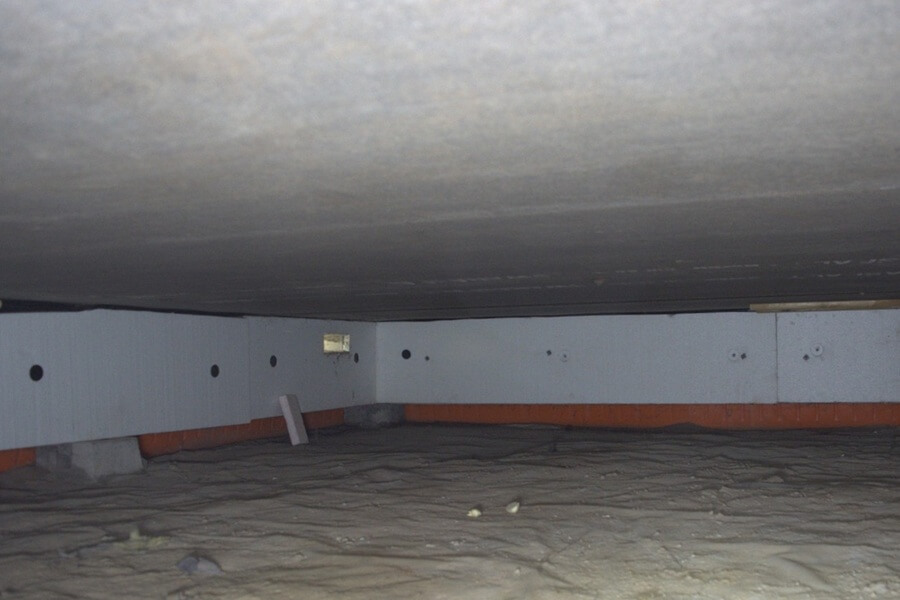
The blind floor, also known as the false floor, is the lower layer of the floor structure of a crawl space or a croft. It is the surface layer that is visible from the inside of the foundation and is installed under the floor joists - it can be described as the "roof" of the crawl space. The picture above shows a blind bottom with an asphalt board, seen from below the crawl space.
The false floor keeps the insulation material in place and acts as a protection against the underlying foundation. However, an outside-ventilated crawl space is exposed to high humidity during summer and autumn, which increases the risk of mould and rot in the false floor.
Here we look at the most common problems and the most effective solution to protect crawl spaces and blind floors.
The blind bottom has a central role in a crawl space construction. It holds the insulation in place so it doesn't collapse or shift, while acting as an extra barrier against cold, ground moisture, draughts and pests from the ground below.
The material of the blind bottom varies depending on when the house was built. Common examples are oiled decking board, wood fibre board (masonite), laminated wood, plywood, chipboard, asphalt board or hard-pressed insulation. In older crofting foundations, raw sheet piling was often used and the croft floor was filled with sawdust, peat or other organic materials.
One of the biggest challenges of an outside-ventilated crawl space is moisture, especially during spring, summer and autumn. When warm air is drawn in and meets the cold surfaces of the crawl space, condensation forms.
In the past, when stoves, wood-burning stoves and boilers were used daily, a lot of heat leaked out through the floor because of poor insulation. The waste heat raised the temperature in the crawl space and helped dry out the moisture.
Later, when the houses were additionally insulated and they switched to electric heating or district heating, this heat supply disappeared. The crawl space became colder and, combined with the fact that ventilation often deteriorated, the risk of condensation and moisture damage increased.
Moisture in the crawl space can penetrate the false floor and further up into the insulation, creating a favourable environment for mould, rot and bad odours.
Common signs of moisture penetrating the blind bottom:
In the worst case, prolonged high humidity in the crawl space can lead to mould growing in the structure, for example in the floor joists. This is often visible, but can sometimes be hidden.
Mould can manifest itself in different ways, for example as a white layer of dust, black spots (black mould) or blue mould (ranging from grey to yellow-brown, green, bluish and black). Hidden mould can also occur on the top of the blind floor, in the insulation or further up in the joists - depending on how damp the building material has become.
⚠️ If you have discovered mould in the false floor, this must be cleaned up before you can start working preventively with a dehumidifier, for example. It may be necessary to replace the false floor and other infested materials. Seek the help of a professional - our partners have extensive experience in mould remediation and damp measures.
The risk of mould increases drastically when the relative humidity is above about 75% for a long time. Therefore, it is important to both know and control the moisture level in the crawl space. By keeping track of the values, you can detect risks in time and ensure that the foundation remains dry and protected.
To protect the crawl space, a desiccant dehumidifier the most effective solution. It keeps the humidity below the critical limits where neither mould nor rot can develop. The result is a long-term measure that preserves the crawl space while contributing to a better indoor climate.
In addition, a desiccant dehumidifier provides more benefits: the floors feel warmer and problems with so-called soil odour can be avoided because the dehumidifier creates a controlled negative pressure.

At Acetec you will find desiccant dehumidifiers that are specially developed for crawl spaces and other cold, moisture-prone spaces. They work energy-efficiently even at low temperatures and help you avoid problems with stale odours, mould and moisture damage. The dehumidifier only operates when there is a need for dehumidification, in between it goes into standby mode.
Our models EvoDry RCF 12 and EvoDry RCF 20 are usually installed in crawl spaces or cold attics. They come with an external control panel that makes control both simple and advanced at the same time. All settings are made directly via the panel, where you can monitor both moisture content and temperature. If the climate becomes unfavourable, clear alarms appear on the display. In addition, there are several functions, such as energy saving mode and the ability to fine-tune operation as needed.
Here you can read more about what to consider when you installing a dehumidifier in the crawl space. With the right installation and an efficient desiccant dehumidifier from Acetec, you can feel confident that both the blind bottom and the crawl space as a whole will remain in good condition for a long time to come.
